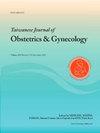产前超声诊断严重右侧肾积水和输尿管积水胎儿中含有SHANK3的5.44 mb从头22q13.31q13.33缺失与r(22)(p12 .2q11.31)和22单体嵌合相关,并通过定量荧光聚合酶链反应确定缺失和r(22)的母体来源
IF 2
4区 医学
Q2 OBSTETRICS & GYNECOLOGY
引用次数: 0
摘要
目的介绍新生儿22q13.3基因缺失与嵌合r(22)和产前超声异常相关的产前诊断。病例报告一名32岁的初产妇在妊娠30周时因产前超声检查异常而接受羊膜穿刺术。妊娠22周的产前超声显示右侧肾积水和输尿管。羊膜穿刺术在21/21个培养的羊膜细胞中发现核型为46、XX、r(22)。对未培养羊膜细胞提取的DNA进行同步阵列比较基因组杂交(aCGH)分析,结果显示arr [GRCh37] 22q13.31q13.33 (45,736,280,51,178,264) × 1,包含SHANK3的22q13.31q13.33缺失5.44 mb。因此,r(22) = r(22)(p11.2q13.31)。妊娠30周的II级超声显示严重的右侧肾积水和输水。随后终止妊娠,生下一个面部畸形的畸形女胎儿。对脐带提取的DNA进行出生后aCGH分析,证实了22q13.3缺失和r(22)的产前诊断,对脐带提取的DNA和父母血液进行定量荧光聚合酶链反应(QF-PCR)分析,确定了22q13.3缺失的母亲来源。脐带核型为46,XX,r(22)(p11.2q13.31)[34]/45,XX,-22[6]。亲本核型正常,不存在这种缺失。结论22q13.3缺失的胎儿在胎儿超声上可出现单侧肾积水和输尿管积水。本文章由计算机程序翻译,如有差异,请以英文原文为准。
Prenatal diagnosis of a 5.44-Mb de novo 22q13.31q13.33 deletion encompassing SHANK3 associated with mosaicism for r(22)(p11.2q11.31) and monosomy 22 in a fetus with severe right hydronephrosis and hydroureter on ultrasound and determination of a maternal origin of the deletion and r(22) by quantitative fluorescent polymerase chain reaction
Objective
We present prenatal diagnosis of a de novo 22q13.3 deletion in a fetus associated with mosaic r(22) and abnormalities on prenatal ultrasound.
Case Report
A 32-year-old, primigravid woman was referred for amniocentesis at 30 weeks of gestation because of abnormalities on prenatal ultrasound. Prenatal ultrasound at 22 weeks of gestation revealed right hydronephrosis and hydroureter. Amniocentesis revealed a karyotype of 46,XX,r(22) in 21/21 colonies of cultured amniocytes. Simultaneous array comparative genomic hybridization (aCGH) analysis on the DNA extracted from uncultured amniocytes revealed the result of arr [GRCh37] 22q13.31q13.33 (45,736,280–51,178,264) × 1 with a 5.44-Mb 22q13.31q13.33 deletion encompassing SHANK3. Therefore, the r(22) was r(22)(p11.2q13.31). Level II ultrasound at 30 weeks of gestation revealed severe right hydronephrosis and hydroureter. The pregnancy was subsequently terminated, and a malformed female fetus was delivered with facial dysmorphism. Postnatal aCGH analysis on the DNA extracted from umbilical cord confirmed the prenatal diagnosis of 22q13.3 deletion and r(22), and quantitative fluorescent polymerase chain reaction (QF-PCR) analysis on the DNA extracted from umbilical cord and parental bloods determined a maternal origin of the 22q13.3 deletion. The umbilical cord had a karyotype of 46,XX,r(22)(p11.2q13.31)[34]/45,XX,-22[6]. The parental karyotypes were normal, and the parents did not have such a deletion.
Conclusion
Fetuses with 22q13.3 deletion may present unilateral hydronephrosis and hydroureter on fetal ultrasound.
求助全文
通过发布文献求助,成功后即可免费获取论文全文。
去求助
来源期刊

Taiwanese Journal of Obstetrics & Gynecology
OBSTETRICS & GYNECOLOGY-
CiteScore
3.60
自引率
23.80%
发文量
207
审稿时长
4-8 weeks
期刊介绍:
Taiwanese Journal of Obstetrics and Gynecology is a peer-reviewed journal and open access publishing editorials, reviews, original articles, short communications, case reports, research letters, correspondence and letters to the editor in the field of obstetrics and gynecology.
The aims of the journal are to:
1.Publish cutting-edge, innovative and topical research that addresses screening, diagnosis, management and care in women''s health
2.Deliver evidence-based information
3.Promote the sharing of clinical experience
4.Address women-related health promotion
The journal provides comprehensive coverage of topics in obstetrics & gynecology and women''s health including maternal-fetal medicine, reproductive endocrinology/infertility, and gynecologic oncology. Taiwan Association of Obstetrics and Gynecology.
 求助内容:
求助内容: 应助结果提醒方式:
应助结果提醒方式:


